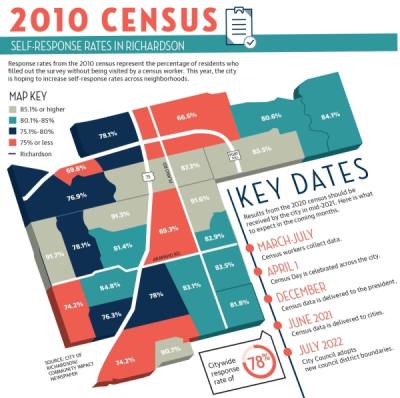The census takes place every 10 years and aims to count each person living in the United States, according to the U.S. Census Bureau. At the municipal level, the data determines council districts and the distribution of federal funds, among other items.
Due to demographic shifts in Richardson, the city expects a complete count will be slightly more difficult this time around. That is why it is investing $16,000 to ensure citizens participate in the census, according to Assistant City Manager Shanna Sims-Bradish.
“The goal is to exceed the 2010 [response rate] because we are putting more effort into outreach and education,” she said.
In 2019, the city partnered with the U.S. Census Bureau to form a Complete Count Committee. The group, made up of 21 representatives from across Richardson institutions, began strategizing earlier this year on how to increase awareness, mobilization and participation.
Importance of a complete count
The last census in Richardson saw a 78% self-response rate and counted the population at 99,223, according to the bureau. Data from the 2010 census shows that Richardson tied with Plano for the third-highest self-response rate among 12 cities in the region.
The city relies heavily on federal funds to support its growing citizenry. This is where the census comes in. Each year, federal agencies rely on census data to calculate the distribution of $675 billion to states, counties and municipalities. At the city level, an inaccurate count could lead to less federal funding to support services, such as transportation and public education, Sims-Bradish said.
“If your population is reported lower than it actually is, you probably have more service needs than you know,” she said.
Because of its size, Texas is the third-largest recipient of federal funding allocated through census data, according to the Texas Demographic Center. An undercount of the state’s population by just 1% could result in a $300 million loss in federal funds, according to the center.
Census data is also used to determine the number of congressional seats and the electoral college votes each state has. This is especially important, as early estimates project Texas’ population growth could lead to an additional two or three seats in the U.S. House of Representatives, according to city officials.
All of these factors are behind Richardson’s push for a comprehensive count in 2020, Sims-Bradish said. But greater legwork is expected in areas deemed by the census as “hard-to-count,” she said.
'Hard-to-count’
Certain socio-demographic groups are at risk of being undercounted, according to the bureau. Hard-to-count communities include members who are immigrants, college students, children under the age of 5, people who face language barriers, families who move frequently and people with mental or physical disabilities.
The 2010 census listed Hispanic or Latino residents as 17.1% of the city’s population, or 16,967 people. In 2018, these citizens accounted for 18.7% of the population, or 22,621 people, according to the bureau’s estimates.
These residents tend to face language barriers, live in multigenerational housing or harbor suspicion over how census data is used, all of which puts them at risk of being undercounted, according to the bureau.
Due to the negative rhetoric surrounding immigration, many immigrant households may be reluctant to participate. This has proven to be one of the biggest obstacles in convincing Hispanic and Latino residents to respond, said Richardson Police Department Sgt. Frank Bradford, who heads up UNIDOS, the city’s Hispanic community outreach program.
“Not knowing the entire process and thinking that the government is going to use that information to target them to deport them—that is a major hurdle,” he said.
Bradford said UNIDOS is working with area Catholic churches and apartment complexes to make sure they are sharing accurate information about the census.
“We are going to continue to push out the message until the census tells us it’s done,” he said. “It’s very important that we overexplain the importance of it.”
Reaching out to multilingual families is also an important piece of Richardson ISD’s census awareness efforts, said Melissa Heller, RISD executive director of strategy and engagement.
She said the district is partnering with local parent-teacher associations to design campus awareness events, especially at schools in hard-to-count neighborhoods.
What to expect
Residents will begin receiving mailed invitations to respond to the census between March 12-20, according to the bureau. Those who do not respond will receive several reminder postcards before being visited by a census worker, said Sue Linder-Linsley, assistant regional census manager for the Dallas region.
For the first time, citizens will have the option to respond online in addition to by phone or by mail. The bureau expects that this option will encourage more citizens to respond, Linder-Linsley said.
“With the additional online and phone options, the census anticipates a larger self-response rate than ever before,” Linder-Linsley said.
Others worry that the online option could alienate citizens without access to Wi-Fi. That is why the Richardson Public Library and area nonprofit Network of Community Ministries have set up dedicated computers for anyone who would like to complete the census online.
Richardson will not receive census data until about six months after it is delivered to President Donald J. Trump in December. Once the data is received, staff will begin analyzing how City Council district boundaries should shift based on new population numbers.







